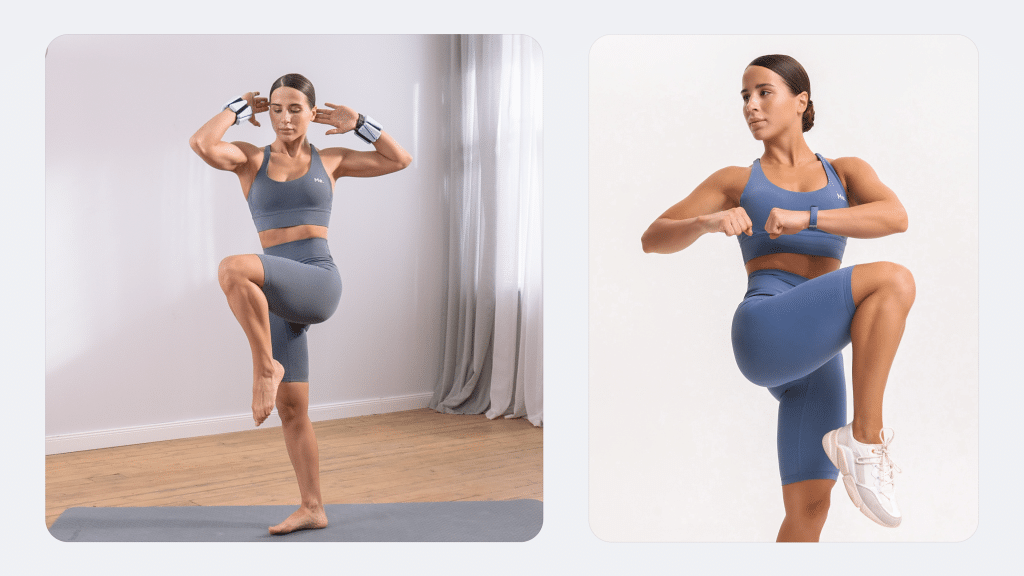Once you’ve gotten over the newness of a fitness routine, the question then becomes how often and how much you should be doing. It can be hard to know just what works best, especially when there’s so much science behind it.
You’ve probably heard the words hypertrophy, muscular endurance and strength training thrown around, but what do they mean and how do you know which one is right for you? Should these even be incorporated into your routine at all?
To help you make sense of the best workout frequency and intensity for your needs, we’ve written a comprehensive guide to help you determine how many workouts per day are right for you, as well as which practices should be included in each session.
First Things First: Workout vs Exercise
For clarity, it’s important to understand the difference between exercise and workout. Exercise is any physical activity that increases your heart rate, while a workout is an organized routine of exercises that are designed to build, strengthen or tone your muscles. Any exercise can become part of a workout, but not all workouts include exercises.
Here’s a simpler example—jogging is an exercise, while a jogging routine could be considered a workout. In lifting weights, a squat is an exercise, while a repetition of sets of squats and other exercises is considered a workout.
In this article, the word “workout” is used to refer to an organized routine of physical activity. For example, when we say one workout per muscle group, we mean one session devoted to that muscle group.
The word “exercise”, on the other hand, refers to the specific activities included in the workout. For example, when we say how many exercises per workout, we mean how many activities are included in the session.
How Many Different Workouts Per Day Is Ideal?
Experts agree that you should aim for a minimum of two to three workouts per week (1). This ensures you have enough time for your muscles to recover between sessions and your body to adapt to the new stimuli. However, if you want to optimize for gains, it’s recommended that you do four to five workouts per week.
Now if you’re trying to optimize your gains and are wondering how to manage two workouts per day, we have some advice. It’s possible to do two workouts per day, but it should be done with caution and an understanding of the risks involved.
The truth is that when done correctly, all you need is one workout a day. By correctly, we mean working out with enough intensity and duration to induce a training response. You’ll be able to benefit from the physical gains, but not stress your body too much and risk injury.
Beginners, and anyone who is just getting back into an exercise routine, should start with one session per day. There’s no clear benefit to doing two workouts a day, and the risk of injury is too great.
Athletes, those training for a competition, and those who’ve been exercising consistently for over a year might want to consider two workouts per day. This allows for more specific training and greater gains, but only when done correctly.
Whether you’re a workout beast or just a beginner making your first foray into the world of fitness and dieting – BetterMe has a lot to offer to both newbies and experts! Install the app and experience the versatility first-hand!
Are There Any Benefits of Working Out Twice a Day?
Under the right guidance, there can be additional benefits to doing two workouts per day.
Increased Training Volume
Research shows that training volume determines your level of success when it comes to building muscle and strength (2). By doing two workouts per day, you can increase your training volume and therefore get greater gains in a shorter amount of time.
More Room for Specificity
You’ll have more time to dig deep and focus on specific areas that need improvement. This includes focusing on the small muscle groups, which are often overlooked in a single workout session. You’ll also have time to perfect your form, improve your technique and generally progress better.
Accelerated Muscle Growth
Muscle growth, also called hypertrophy, is the result of exposing your muscles to a stress that’s greater than what they’re used to. By increasing the training volume, you’re putting a greater strain on your muscles and this can lead to faster muscle growth (3).
Read more: 20 Days Workout Challenge For Healthy Weight Loss And Increased Muscle Mass
The Drawbacks of Doing Two Workouts Per Day
The drawbacks of working out twice a day may make you reconsider making this bold move:
- Injury Risk
The biggest risk of doing two workouts per day is that your body won’t have enough time to recover between sessions. This increases your risk of injury, as you’ll be pushing your body too hard without giving it a chance to recover.
- Loss of Motivation
The lack of rest and recovery time can also lead to loss of motivation due to fatigue and exhaustion. This can be counteracted through proper nutrition, rest, and recovery strategies to ensure that you are giving your body the fuel it needs to perform at its best.
- Decreased Performance
Doing two workouts per day can also lead to decreased performance, as your body won’t be as fresh and energized for the second session. This can lead to a less-than-optimal workout and ultimately, poor results.
- Dietary Considerations
You’ll also need to take into account your nutrition when doing two workouts per day. You’ll need to make sure you’re getting enough fat, protein and carbohydrates to meet your energy needs, as well as a sufficient amount of micronutrients to aid in recovery.
More importantly, you’ll need to structure your diet around your training sessions. This means eating within an hour of each session to ensure that your muscles are receiving the nutrients they need to recover quickly and efficiently. It also means eating enough throughout the day to ensure you have enough energy for both sessions without feeling fatigued.
How Should You Approach Doing Two Workouts Per Day?
If you want to do two workouts per day, approach it with caution:
Workout Choice
First and foremost, a good tip would be to design two moderate-intensity workouts. The intensity should be in the 70-80% range. This means your workouts should be challenging, but not so intense that you can’t recover fully between sessions.
The workouts you choose must also target different muscle groups so that you don’t overwork them. For example, you can do a lower-body workout in the morning and an upper-body workout in the evening. Or you can cross train; do cardio in the morning and weight training in the evening.
Workout Timing
The timing of your workouts is also important. You should leave at least six hours between sessions to ensure that you have enough time to recover. This means that if you’re doing a morning session, the second one should be in the late afternoon or early evening.
Workout Duration
Keep your workouts short and sweet. Aim to finish each session within 45 minutes to an hour so that you don’t overtax your system. Consider which exercises take longer to complete and which ones can be done in shorter time frames. Structure your workouts around these principles for maximum efficiency.
For example, the longer workouts could be done earlier in the day, while the shorter workouts could be done in the evening. This will give you enough time to rest and recover before your next session.
Effort and Intensity
The workout that needs the most effort and intensity should be done first. This way, you can ensure that your body is at its peak performance for the more challenging session. Say, for example, you’re doing a weight-training session followed by a cardio session. You should do the weight-training session first and then reduce the intensity of the cardio session.
But this ultimately comes down to the intensity of the workouts that you are planning to complete. You could do a lighter session in the morning to get yourself ready for the day and then go with a strenuous heavy workout in the evening. This would still allow you to rest and recover before the next heavy session.
Discover Micro Workouts for Weight Loss that fit seamlessly into your busy schedule, maximize calorie burn, and help you achieve your fitness goals without needing hours at the gym.
Sets, Reps, and Rest In Between
How many exercises per session are ideal for two workouts per day? Depending on your style of training, three to four exercises could be enough for each session. If you’ve carefully selected and arranged the exercises for maximum efficiency, you should be able to complete the entire workout in 30-45 minutes.
Maximum efficiency here means:
- You’re performing both compound and isolation exercises in a 80/20 ratio (80% compound exercises, 20% isolation exercises).
- You’re taking 1-2 minutes of rest between sets for multi-joint/compound exercises and 30-45 seconds of rest between sets for single-joint/isolation exercises.
- You’re doing 3-4 sets of 8-12 reps for compound exercises and 3 sets of 15-20 reps for isolation exercises.
- You should be able to complete the entire workout in 45 -60 minutes or less.
- You’re lifting a weight that is challenging enough to complete the given reps with good form.
When it comes to weight loss, progress is made by inches, not miles, so it’s much harder to track and a lot easier to give up. The BetterMe: Health Coaching app is your personal trainer, nutritionist, and support system all in one. Start using our app to stay on track and hold yourself accountable!
Movement Patterns vs Muscle Groups
Ideally, all muscle groups should get a workout at least twice a week. However, a quick look at muscle anatomy shows that this can be difficult to achieve with only 3-4 exercises per session.A solution to this is to choose movement patterns instead of muscle groups.
Remember, the body is meant to function as a unit and muscles rarely work in isolation. Choose a variety of exercises that target different movement patterns like push, pull, hip hinge, squat and lunge. This way, you’ll target multiple muscle groups with each exercise.
Rest and Recovery
So, you have only 6 hours in between your two workouts. What do you do in the meantime? REST! That’s right, rest and recovery between sessions is just as important as the workout itself (4).
A nap can be beneficial as it helps restore energy levels and your body’s ability to recover. If you don’t have time for a nap, even just 10-15 minutes of meditation can help relax your mind and body.
Night time is also important for recovery. Make sure you get enough sleep and stick to a regular sleeping schedule. A lack of sleep will greatly reduce your body’s ability to recover, so make sure you get at least 7-8 hours of sleep each night. Do not sacrifice sleep for another workout session. A majority of muscle recovery comes when we are asleep.
If you can, also try to include active recovery days into your schedule (2). These are days when you don’t do any intense physical activity, but rather focus on gentle movements and stretching. This will help keep your body healthy and flexible, as well as give it a chance to recover from the intense workouts that you do.
The truth is, even athletes and professional bodybuilders need rest days. So make sure to give your body the time it needs for recovery.
Diet and Nutrition
You might need to adjust your eating habits as well. Eating small meals throughout the day can help you maintain energy levels and give your body enough fuel for recovery.
Limit the calorie consumption on rest days because you are not exerting as much energy/burning as many calories. But then for training days you could increase your calorie intake to get you through the multiple training sessions.
Nutrition is an important part of any fitness program, so make sure you’re taking in enough proteins and carbohydrates to support your workouts (5). Eating healthy fats can also help you stay energized and reduce inflammation.
Finally, make sure to stay hydrated. Drinking plenty of water will help maintain the electrolyte balance in your body and keep you hydrated throughout the day.
Read more: Is Calisthenics Better Than Weights?
How Many Workouts Per Day to Lose Weight?
Weight loss comes down to a simple equation – burning more calories than you consume (6). Lifting weights helps you burn calories as you use up energy to move the weights. It also increases your muscle mass, which helps burn fat even when you’re not working out (7).
However, the key is to find the right balance of exercise and rest. Too much exercise can put a lot of strain on your body and make it harder to recover, while too little exercise can make it harder to see results.
Just like we mentioned before, one workout per day is enough to see results. You can also do two workouts per day, but only if you’ve been lifting for a while and you’re sure your body can handle it.
Working with a certified trainer, nutritionist or dietician can also help you create the best plan for your individual needs.
For bulking, it’s generally recommended to perform one workout per day. This allows you to focus on high-intensity, resistance training sessions that are essential for muscle growth. Most effective bulking routines involve training 4-6 times per week, targeting different muscle groups each day. This ensures adequate recovery time for each muscle group while promoting optimal muscle hypertrophy and strength gain. We’ve detailed the Benefits of Micro Workouts to show you how even short bursts of exercise can enhance your fitness routine, boost your metabolism, and fit effortlessly into your daily life for maximum impact. Yes, 6 exercises per workout can be sufficient, depending on your training objectives and how the exercises are structured. A well-rounded workout routine should include compound movements such as squats, deadlifts, and bench presses, which engage multiple muscle groups simultaneously (8). By incorporating a mix of compound and isolation exercises, you can efficiently target all major muscle groups. Ensure your routine is balanced and includes variations to prevent plateaus and overtraining. Yes, 3 workouts a day is generally considered excessive for most individuals and can lead to overtraining, increased risk of injury, and burnout. The body needs time to recover between workouts to allow muscles to repair and grow. Instead, you should focus on one well-structured workout per day that targets specific muscle groups and allow for rest days in your weekly routine. This approach enables sustainable progress and reduces the risk of overuse injuries. This 6-week workout plan at home is designed to transform your body with minimal equipment and offers easy-to-follow routines that build strength, improve endurance, and help you achieve your fitness goals – all from the comfort of your own home. Yes, performing 3 sets of 10 repetitions is a classic and effective strategy for building muscle, particularly for beginners and intermediate practitioners. This approach, which is known as the hypertrophy range, provides sufficient stimulus for muscle growth while managing fatigue. To maximize muscle gains, ensure progressive overload by gradually increasing the weight or resistance as you become stronger (3). In addition, incorporate variations in your routine over time to continue making progress. Yes, getting fit in 6 months is an achievable goal with a consistent and well-balanced training program. A combination of cardiovascular exercise, strength training, and proper nutrition can lead to significant improvements in fitness levels, body composition, and overall health within this timeframe. Establish clear goals, track your progress, and remain consistent with your workouts and diet. Tailoring your routine to your personal fitness level and gradually increasing intensity will help you achieve your fitness objectives.Frequently Asked Questions
How many workouts should I perform per day for bulking?
Is 6 exercises per workout enough?
Is 3 workouts a day too much?
Is 3 sets of 10 enough to build muscle?
Can you get fit in 6 months?
The Bottom Line
Two workouts per day can be beneficial for athletes and individuals who are already in shape and have been exercising for a while. However, it’s important to remember that there are risks involved and you should approach this with caution. If you must do it, you should work with a qualified professional who can offer you guidance and advice on how to safely manage two workouts per day.
DISCLAIMER:
This article is intended for general informational purposes only and does not serve to address individual circumstances. It is not a substitute for professional advice or help and should not be relied on for making any kind of decision-making. Any action taken as a direct or indirect result of the information in this article is entirely at your own risk and is your sole responsibility.
BetterMe, its content staff, and its medical advisors accept no responsibility for inaccuracies, errors, misstatements, inconsistencies, or omissions and specifically disclaim any liability, loss or risk, personal, professional or otherwise, which may be incurred as a consequence, directly or indirectly, of the use and/or application of any content.
You should always seek the advice of your physician or other qualified health provider with any questions you may have regarding a medical condition or your specific situation. Never disregard professional medical advice or delay seeking it because of BetterMe content. If you suspect or think you may have a medical emergency, call your doctor.
SOURCES:
- WHO GUIDELINES ON PHYSICAL ACTIVITY AND SEDENTARY BEHAVIOUR (2020, iris.who.int)
- The effect of training volume and intensity on improvements in muscular strength and size in resistance-trained men (2015, nih.gov)
- Progression of volume load and muscular adaptation during resistance exercise (2014, nih.gov)
- An Evidence-Based Approach for Choosing Post-exercise Recovery Techniques to Reduce Markers of Muscle Damage, Soreness, Fatigue, and Inflammation: A Systematic Review With Meta-Analysis (2018, nih.gov)
- Editorial: Nutritional Strategies to Promote Muscle Mass and Function Across the Health Span (2020, nih.gov)
- Metabolism and weight loss: How you burn calories (2022, mayoclinic.org)
- Increasing muscle mass to improve metabolism (2013, nih.gov)
- WHAT ARE COMPOUND EXERCISES? (2024, fitnesseducation.edu.au)











